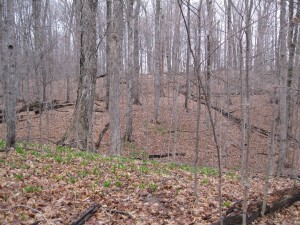In Oshtemo Township, it’s 64 degrees and sunny this afternoon and the wood frogs in the pond close to the road were clacking loudly. This morning though, a few miles away at Harris Sanctuary, it was high 30s at the beginning and high 40s at the end.
I spent the early part of the morning in the beech-maple forest. It’s still early spring and none of the spring wild flowers are blooming yet. A few things are up, notably wild leek. It’s abundant in this sanctuary. The flowers don’t appear till June, long after the leaves are gone. A few of last year’s flowering stalks are still upright–dry and pale tan–and a few of these still retain a black, shiny round seed. Never more than one on any I noticed.
I saw quite a few patches of bedstraw, Galium aparine. This early, they are short thin stems with whorls of miniature leaves.
A fair number of toothwort (Dentaria laciniata) plants were up and had buds. Maybe they’ll be the first plants to flower here. In a beech-maple forest in Pavilion Township I visited last weekend, harbinger of spring was in full bloom, but the species doesn’t occur at Harris.

Beech-maple forest at Mildred Harris Sanctuary. The green is wild leek. Photograph April 9, 2011 by Richard Brewer
In 40 minutes or so of walking, I found only one small patch of garlic mustard. This includes my visiting 20 or so flagged sites where we had found and pulled garlic mustard in past years. The new patch was not near any of the old ones. But someone else might have spotted other plants. The garlic mustard is short, just basal leaves; some other plants might have popped out for someone with good color vision.
I then picked up trash along the two roads that adjoin the sanctuary and walked back to the car through the field half of the sanctuary. One plant species was in bloom in the field–a low member of the mustard family with small, very small, white flowers. With its four white petals, it was pretty obviously a mustard, but I couldn’t satisfy myself just what the species was. Probably in a week or so, when some of the flowers give rise to fruits, it’ll be easier to key out. It seemed to be a weed of the old hayfield–none in the woods.
I wasn’t paying a lot of attention to birds, but turkey gobbling was coming from two directions when I went into the woods. They quieted down before 9:30 AM. Red-bellied Woodpeckers and flickers were making noise and there was evidence on some of the dead trees of Pileated work. As I was walking alongside the field a pair of Wood Ducks flew over making the distinctive upward-slurred “Ooh-eek.” I’ve read that it’s the female that makes this call, but the two birds are usually together when I hear
it and I’m not sure that the male never produces it.
And there were Tufted Titmice singing in the woods and Field and Song Sparrow singing at the edges of the field. And a few more I haven’t listed.
Back Tuesday for our second stewardship work day.

